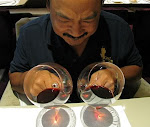Had a couple of long meetings and stuff in between. A bit hectic and stressful. Good thing the Doc called for a few pre-dinner drinks at the Stockbroker's wine shop not far away from my office (I didn't have a camera - so no pics). I got there at 5:30pm, the Stockbroker was already there.
The Doc's brother, James, arrived shortly thereafter and we started off with a Veuve Clicqout NV Brut Yellow Label from him. The Doc arrived from the hospital a few minutes after. With some cheese, hot, crusty bread and nice Italian butter we had:
1996 Château Tertre Rôteboeuf - The Stockbroker's, already in a decanter by the time I arrived. Initially, thick pungency of truffles held sway over some earthy dried dark fruit and cedar.In the mouth, the wine was not as rich, ripe and extracted as the bouquet suggested it would be: barely medium-bodied, a pure, sheer silk sheet of virtually seamless plum, cherry, raspberry, cassis, espresso, violets and cedar. Decent length.
After more breathing in glass, the had truffles materially faded from the bouquet, and, in its dominant position emerged sweetish, cinnamon-laced ripe plum, dark fruit compote, fig, espresso, minerals and delicately spiced/toasty oak. In the mouth, the wine held as it was earlier save that it seemed to have gained a little weight and incorporated the minerals and mentioned oak notes.
1982 Château Gruaud Larose - James' bottle. Textbook nose of smoky cedar, asphalt, mushrooms, leather, tobacco, cassis, earthy dark fruit, mere hints of anise and minerals. Mirrored in the mouth and continued that way throughout. Didn't really budge much. Readily fuller and more heft on the palate, riper in fruit and just a touch more extracted. Vibrant, youthful, belying its 26+ years - tasting even younger than the bottle I entered in our 9th Blind Bordeaux Challenge.
It didn't display the fig notes of the latter though and showed more purity.I wouldn't have guessed this (or my previous bottle of the same wine) to be an '82. Probably the most youthful '82 I've ever had. The Stockbroker and Doc said the same thing. Many, many years more in this wine.
Thanks, guys. I needed that.
Friday, January 30, 2009
Monday, January 26, 2009
Rob & Sunshine's Gourmandise Dinner: 24th January 2009
Dinner this past Saturday was Rob & Sunshine's latest Gourmandise Menu at their Global Academy. Rene organized a table of 8: he, Aimee, Maite, Monica, Doc, Mrs. Doc, my brother and myself. Tita B was at another long table with members of her family. Rene and I ran a bit late and I was the last of our table to arrive.
At the outset, Doc lamented that his bottle of 2001 E. Guigal Ermitage Ex-Voto Blanc was off - to the point of being undrinkable. Apparently, both he and the Stockbroker have had an unfortunate string of strange-tasting bottles of this same wine. I tasted, nonetheless, but the Doc was right - it was nothing like the past bottles we've enjoyed a couple of years ago. I asked that the bottle be set aside and not be dumped, though, just in case it "wakes up" later on. It never did though.
Unfortunately, halfway through the multiple courses, the Doc, already feeling bad earlier in the day, was taken ill, turned a bit pale and thought it best to go home early - leaving us to finish off his bottle of 1994 Château Angelus. Good friends that we are, we made sure his bottle didn't go to waste.
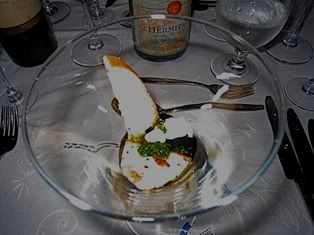 Dinner started off with a Paella Negra Cocktail, an entertainingly whimsical spin on squid ink paella using squid inked sago balls instead of rice. A truly amusing amuse bouche. With it I tried a sip from my 2002 E. Guigal Hermitage Blanc - yet another strange-tasting bottle - disturbingly closed, virtually no fruit to speak of, grudgingly showing only white mineral and a bit of metal.
Dinner started off with a Paella Negra Cocktail, an entertainingly whimsical spin on squid ink paella using squid inked sago balls instead of rice. A truly amusing amuse bouche. With it I tried a sip from my 2002 E. Guigal Hermitage Blanc - yet another strange-tasting bottle - disturbingly closed, virtually no fruit to speak of, grudgingly showing only white mineral and a bit of metal.
I thought maybe the wine was just too cold and let it warm up for the next course, which was Beet Cannelloni Stuffed with Goat Cheese, Sprinkled with Orange Dust and Pine Nut Shards.
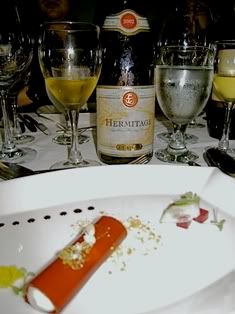 Another amusing dish, the flavors very subtle - more a treat for the eyes and mind than the palate I found - but, then, I have very simple taste in food and personally gravitate towards bold, robust flavors of French country cuisine more than nouvelle. That said, it was a nice change from the usual mille-fuille style red beet preparations many chefs have been serving in the recent past.
Another amusing dish, the flavors very subtle - more a treat for the eyes and mind than the palate I found - but, then, I have very simple taste in food and personally gravitate towards bold, robust flavors of French country cuisine more than nouvelle. That said, it was a nice change from the usual mille-fuille style red beet preparations many chefs have been serving in the recent past.
My 2002 E. Guigal Hermitage Blanc remained stubbornly uninteresting, though, so I just set my bottle and glass aside thereafter.
Next was a superb Roast Squash and Chorizo Bilbao Soup with Hazelnut Powder (plastered on the side) and Sage Butter.
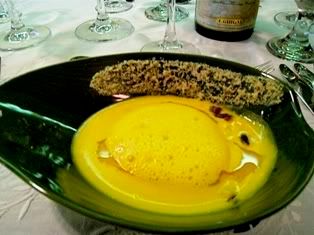 This was my favorite dish of the night. I've always liked squash - roasted/caramelized, as a soup, in any vegetable dish really - so my bias for this course is not surprising. That said, it was very well-executed with the chorizo adding a nice spicy/vaguely smoky flavor to the creamy squash. I think this is the first time I tried this kind of soup laced with chorizo as others I've had involved pancetta, toasted Parma ham and Jamon Serrano instead. Loved it.
This was my favorite dish of the night. I've always liked squash - roasted/caramelized, as a soup, in any vegetable dish really - so my bias for this course is not surprising. That said, it was very well-executed with the chorizo adding a nice spicy/vaguely smoky flavor to the creamy squash. I think this is the first time I tried this kind of soup laced with chorizo as others I've had involved pancetta, toasted Parma ham and Jamon Serrano instead. Loved it.
Next was an indulgent marriage of Unagi and Foie Gras Terrine on Buttered Brioche and Caramelized Apples.
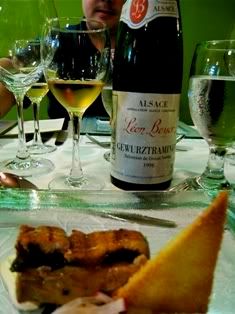 I've tried this combination of unagi and foie gras before, but exactly where and when escapes me. This particular version's rich flavors worked well together, and the toasted butter brioche lent the needed contrast in texture. I intended to ask Rob if it would have been possible to have the skin-side of the unagi a little toasted for added textural contrast and, I imagine, helping the unagi keep the integrity of its own personality a little more. Unfortunately, I forgot to ask him about that before I left.
I've tried this combination of unagi and foie gras before, but exactly where and when escapes me. This particular version's rich flavors worked well together, and the toasted butter brioche lent the needed contrast in texture. I intended to ask Rob if it would have been possible to have the skin-side of the unagi a little toasted for added textural contrast and, I imagine, helping the unagi keep the integrity of its own personality a little more. Unfortunately, I forgot to ask him about that before I left.
 ...which I tried with Rene's 2002 Château Malescot St-Exupery. I chose to pair this young Margaux with this dish because: (1) both the bottles of northern Rhône whites we had were not behaving properly; and, (2) due to its vintage, I expected it to be a bit more reserved, feminine and less ripe and extracted than the other reds we had, and, thereby, friendlier to the chicken.
...which I tried with Rene's 2002 Château Malescot St-Exupery. I chose to pair this young Margaux with this dish because: (1) both the bottles of northern Rhône whites we had were not behaving properly; and, (2) due to its vintage, I expected it to be a bit more reserved, feminine and less ripe and extracted than the other reds we had, and, thereby, friendlier to the chicken.
 I paired this mainly with my bottle of 2001 Badia a Passignano Chianti Classico Riserva - curently my favorite Chianti - always a good pairing with roasted red meats, opting to have most of my share of Doc's 1994 Château Angelus on its own. The 2001 Badia a Passignano (100% sangiovese, my winner in our Blind Non-Bordeaux Challenge II) is as I remember: fullish bodied, nicely rounded and extracted, broad, showing well-knit, earthy dark fruit, kirsh/cherry, bit of raspberry, underlying espresso, with minor notes of roasted meat, mushroom, olive and violets. Nice depth. This time, though, I noticed more toasty oak/vanilla and a slight chocolate nuance.
I paired this mainly with my bottle of 2001 Badia a Passignano Chianti Classico Riserva - curently my favorite Chianti - always a good pairing with roasted red meats, opting to have most of my share of Doc's 1994 Château Angelus on its own. The 2001 Badia a Passignano (100% sangiovese, my winner in our Blind Non-Bordeaux Challenge II) is as I remember: fullish bodied, nicely rounded and extracted, broad, showing well-knit, earthy dark fruit, kirsh/cherry, bit of raspberry, underlying espresso, with minor notes of roasted meat, mushroom, olive and violets. Nice depth. This time, though, I noticed more toasty oak/vanilla and a slight chocolate nuance.
 Best red of the night, however, clearly goes to the Doc's 1994 Angelus. I think the last time I had this wine was from Paco Sandejas, the Doc was with us (19th Feb 2008 dinner at Sala Bistro) and we were both impressed how good a '94 this was. I think this was the bottle that convinced the Doc to start buying some select 1994 Bordeaux. My notes from almost a year ago were as follows:
Best red of the night, however, clearly goes to the Doc's 1994 Angelus. I think the last time I had this wine was from Paco Sandejas, the Doc was with us (19th Feb 2008 dinner at Sala Bistro) and we were both impressed how good a '94 this was. I think this was the bottle that convinced the Doc to start buying some select 1994 Bordeaux. My notes from almost a year ago were as follows:
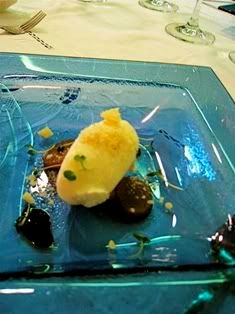 ...and finished with a refreshingly light-handed Vanilla Bean and Yogurt Panna Cotta with Berry Coulis and Almond Tuille (sorry, again no photo). Rene had intended to pair this with his '98 Beyer Gewürztraminer SGN, but, tragically, his open bottle inadvertedly overturned in the cooler and was forever lost. We were fine without it, though, the dessert stood well on its own.
...and finished with a refreshingly light-handed Vanilla Bean and Yogurt Panna Cotta with Berry Coulis and Almond Tuille (sorry, again no photo). Rene had intended to pair this with his '98 Beyer Gewürztraminer SGN, but, tragically, his open bottle inadvertedly overturned in the cooler and was forever lost. We were fine without it, though, the dessert stood well on its own.

At the outset, Doc lamented that his bottle of 2001 E. Guigal Ermitage Ex-Voto Blanc was off - to the point of being undrinkable. Apparently, both he and the Stockbroker have had an unfortunate string of strange-tasting bottles of this same wine. I tasted, nonetheless, but the Doc was right - it was nothing like the past bottles we've enjoyed a couple of years ago. I asked that the bottle be set aside and not be dumped, though, just in case it "wakes up" later on. It never did though.
Unfortunately, halfway through the multiple courses, the Doc, already feeling bad earlier in the day, was taken ill, turned a bit pale and thought it best to go home early - leaving us to finish off his bottle of 1994 Château Angelus. Good friends that we are, we made sure his bottle didn't go to waste.
 Dinner started off with a Paella Negra Cocktail, an entertainingly whimsical spin on squid ink paella using squid inked sago balls instead of rice. A truly amusing amuse bouche. With it I tried a sip from my 2002 E. Guigal Hermitage Blanc - yet another strange-tasting bottle - disturbingly closed, virtually no fruit to speak of, grudgingly showing only white mineral and a bit of metal.
Dinner started off with a Paella Negra Cocktail, an entertainingly whimsical spin on squid ink paella using squid inked sago balls instead of rice. A truly amusing amuse bouche. With it I tried a sip from my 2002 E. Guigal Hermitage Blanc - yet another strange-tasting bottle - disturbingly closed, virtually no fruit to speak of, grudgingly showing only white mineral and a bit of metal.I thought maybe the wine was just too cold and let it warm up for the next course, which was Beet Cannelloni Stuffed with Goat Cheese, Sprinkled with Orange Dust and Pine Nut Shards.
 Another amusing dish, the flavors very subtle - more a treat for the eyes and mind than the palate I found - but, then, I have very simple taste in food and personally gravitate towards bold, robust flavors of French country cuisine more than nouvelle. That said, it was a nice change from the usual mille-fuille style red beet preparations many chefs have been serving in the recent past.
Another amusing dish, the flavors very subtle - more a treat for the eyes and mind than the palate I found - but, then, I have very simple taste in food and personally gravitate towards bold, robust flavors of French country cuisine more than nouvelle. That said, it was a nice change from the usual mille-fuille style red beet preparations many chefs have been serving in the recent past.My 2002 E. Guigal Hermitage Blanc remained stubbornly uninteresting, though, so I just set my bottle and glass aside thereafter.
Next was a superb Roast Squash and Chorizo Bilbao Soup with Hazelnut Powder (plastered on the side) and Sage Butter.
 This was my favorite dish of the night. I've always liked squash - roasted/caramelized, as a soup, in any vegetable dish really - so my bias for this course is not surprising. That said, it was very well-executed with the chorizo adding a nice spicy/vaguely smoky flavor to the creamy squash. I think this is the first time I tried this kind of soup laced with chorizo as others I've had involved pancetta, toasted Parma ham and Jamon Serrano instead. Loved it.
This was my favorite dish of the night. I've always liked squash - roasted/caramelized, as a soup, in any vegetable dish really - so my bias for this course is not surprising. That said, it was very well-executed with the chorizo adding a nice spicy/vaguely smoky flavor to the creamy squash. I think this is the first time I tried this kind of soup laced with chorizo as others I've had involved pancetta, toasted Parma ham and Jamon Serrano instead. Loved it.~ oOo ~
Next was an indulgent marriage of Unagi and Foie Gras Terrine on Buttered Brioche and Caramelized Apples.
 I've tried this combination of unagi and foie gras before, but exactly where and when escapes me. This particular version's rich flavors worked well together, and the toasted butter brioche lent the needed contrast in texture. I intended to ask Rob if it would have been possible to have the skin-side of the unagi a little toasted for added textural contrast and, I imagine, helping the unagi keep the integrity of its own personality a little more. Unfortunately, I forgot to ask him about that before I left.
I've tried this combination of unagi and foie gras before, but exactly where and when escapes me. This particular version's rich flavors worked well together, and the toasted butter brioche lent the needed contrast in texture. I intended to ask Rob if it would have been possible to have the skin-side of the unagi a little toasted for added textural contrast and, I imagine, helping the unagi keep the integrity of its own personality a little more. Unfortunately, I forgot to ask him about that before I left.With this was Rene's bottle of 1998 Léon Beyer Gewürztraminer Sélection de Grains Nobles. This was, to me, the best and most natural pairing of the night. Alsace, wherefrom the wine hails, also produces foie gras and their foie dishes are often paired with their local vendanges tardives (i.e., late harvest) and SGN wines. This wine displayed gracefully balanced sweetness and acidity in its typical gewürz SGN flavors and scents of lightly spiced ripe lychees, roses, cling peach, candied citrus peel and bit of vanilla/oak. Lovely wine, it simultaneously enhanced and cut the dish's richness.
~ oOo ~
Next was a light respite of Rob & Sunshine's version of "Fish and Chips" with White Chocolate and Truffle Sauce. Unfortunately, I don't have a photo of this dish or its pairing wine for some reason - I thought I was able to take one (I didn't have a camera with me so I just borrowed Aimee's), but, I apparently didn't.
With this, we paired Rene's bottle (he was actually the one who introduced me to this wine during his birthday dinner) of 2006 Domaine Raimbault-Pineau Pouilly-Fumé - always a very nice pairing with fish and shellfish. I've written several times about this excellent sauvignon-based Loire white so one can just click on the high-lighted link to gather my notes. As to pairing with this particular dish, the wine's bright acidity and ripeness of fruit helped it stand well with the white chocolate and truffle sauce.
~ oOo ~
Following was a Bacon-Wrapped, Sausage-Stuffed Chicken Roulade with Mushroom Fricassee....
 ...which I tried with Rene's 2002 Château Malescot St-Exupery. I chose to pair this young Margaux with this dish because: (1) both the bottles of northern Rhône whites we had were not behaving properly; and, (2) due to its vintage, I expected it to be a bit more reserved, feminine and less ripe and extracted than the other reds we had, and, thereby, friendlier to the chicken.
...which I tried with Rene's 2002 Château Malescot St-Exupery. I chose to pair this young Margaux with this dish because: (1) both the bottles of northern Rhône whites we had were not behaving properly; and, (2) due to its vintage, I expected it to be a bit more reserved, feminine and less ripe and extracted than the other reds we had, and, thereby, friendlier to the chicken.The wine itself put on a good show considering the vintage (the Stockbroker told me before that 2002s are currently the French's red wines of choice for serving), presenting cassis, dark plum, dark cherry and raspberry, minerals, bit of violets, cedar and toasty/spicy oak profiles. Nice balance and depth to it. Medium bodied, and good structure. There is a slight hint of greenness to the fruit, but, in all, quite enjoyable.
As a match for the chicken roulade, the smoky bacon and savoriness of the sausage stuffing bolsted the chicken and, thus, made for a pretty decent pairing with the red. I would imagine, though, that a nice, "fullish" rosé (like the Eté de Mondot or Rosé de Pavie-Macquin) would have done better - mea culpa - I should have thought of that earlier.
~ oOo ~
Then came the Charbroiled Rib Fillet of Black Angus Beef with Bone Marrow Petit Salad and Potato Purée. This was my close second best dish of the night. I loved the way the meat was cooked, so tender and juicy, yet retaining its "steak" texture and showing a nice, subtle charred smokiness.
 I paired this mainly with my bottle of 2001 Badia a Passignano Chianti Classico Riserva - curently my favorite Chianti - always a good pairing with roasted red meats, opting to have most of my share of Doc's 1994 Château Angelus on its own. The 2001 Badia a Passignano (100% sangiovese, my winner in our Blind Non-Bordeaux Challenge II) is as I remember: fullish bodied, nicely rounded and extracted, broad, showing well-knit, earthy dark fruit, kirsh/cherry, bit of raspberry, underlying espresso, with minor notes of roasted meat, mushroom, olive and violets. Nice depth. This time, though, I noticed more toasty oak/vanilla and a slight chocolate nuance.
I paired this mainly with my bottle of 2001 Badia a Passignano Chianti Classico Riserva - curently my favorite Chianti - always a good pairing with roasted red meats, opting to have most of my share of Doc's 1994 Château Angelus on its own. The 2001 Badia a Passignano (100% sangiovese, my winner in our Blind Non-Bordeaux Challenge II) is as I remember: fullish bodied, nicely rounded and extracted, broad, showing well-knit, earthy dark fruit, kirsh/cherry, bit of raspberry, underlying espresso, with minor notes of roasted meat, mushroom, olive and violets. Nice depth. This time, though, I noticed more toasty oak/vanilla and a slight chocolate nuance.Second best pairing of the night, after the unagi/foie-gewürz SGN pairing.
 Best red of the night, however, clearly goes to the Doc's 1994 Angelus. I think the last time I had this wine was from Paco Sandejas, the Doc was with us (19th Feb 2008 dinner at Sala Bistro) and we were both impressed how good a '94 this was. I think this was the bottle that convinced the Doc to start buying some select 1994 Bordeaux. My notes from almost a year ago were as follows:
Best red of the night, however, clearly goes to the Doc's 1994 Angelus. I think the last time I had this wine was from Paco Sandejas, the Doc was with us (19th Feb 2008 dinner at Sala Bistro) and we were both impressed how good a '94 this was. I think this was the bottle that convinced the Doc to start buying some select 1994 Bordeaux. My notes from almost a year ago were as follows:1994 Château Angelus (St-Emilion, Bordeaux, France) - From Paco Sandejas during dinner on the 19th February at Sala Bistro in Greenbelt 3. Alongside a '99 Léoville Poyferré from me, this was one of the wines Paco, the Doc, I and our wives (though Christine bailed out on us at the last minute - she likely didn't feel like wading through rush hour traffic from Alabang) had with thick prime porterhouse steaks. Actually, Paco gave me a choice between the subject wine and a 1985 Montelena cabernet sauvignon (Napa, California, USA), but, since I hadn't tried the '94 Angelus since mid-2001, I was very curious how it had evolved since then, and, consequently chose that.Now, this bottle was every bit as good. Actually, I realized how sick the Doc was since, early in the evening, before he left, he said that it tasted like it was "falling apart". It certainly didn't taste that way to me and Rene. I add now that there are discreet, underlying espresso and chocolate notes to this wine, and, that the finish, though not exceedingly long, was very correct and by no means short.
My old notes on the wine state that there was a brooding heaviness and reluctance to the wine's dark plum/red fruit/black olive earthiness back in 2001. Well, almost 7 years later, at the mentioned dinner, that was certainly not the case. Despite the lack of decanting and material brething time in the glass, the '94 Angelus was singing with an open, complex bouquet of sweet red cherry (kirsch as well?) over some modestly ripe (definitely one of the riper '94s I've tried, a vintage of Bordeaux that is reputed to have greenness to its fruit), dark plum, faint black olive, spice, cedar and a touch of camphor. There was a nice, mild underlying earthiness to it. These profiles were mirrored on the palate in a lush, medium-to-full body.
The finish was a bit short, but very forgivable considering its vintage, alluring bouquet and generous middle. Over-all, one of the best '94 Bordeaux I've had.
~ oOo ~
We then wound down the meal with a dish of Parmigiano-Reggiano Gelato and Crumbs, Poached Pears in Red Wine and Aged Balsamico....
 ...and finished with a refreshingly light-handed Vanilla Bean and Yogurt Panna Cotta with Berry Coulis and Almond Tuille (sorry, again no photo). Rene had intended to pair this with his '98 Beyer Gewürztraminer SGN, but, tragically, his open bottle inadvertedly overturned in the cooler and was forever lost. We were fine without it, though, the dessert stood well on its own.
...and finished with a refreshingly light-handed Vanilla Bean and Yogurt Panna Cotta with Berry Coulis and Almond Tuille (sorry, again no photo). Rene had intended to pair this with his '98 Beyer Gewürztraminer SGN, but, tragically, his open bottle inadvertedly overturned in the cooler and was forever lost. We were fine without it, though, the dessert stood well on its own. 
Very enjoyable evening. Our compliments to the chefs, and thanks to Rene for organizing our table.
Saturday, January 24, 2009
The Stockbroker's Barolo Lunch.
 Yesterday's Barolo lunch (23rd January) at Pepato was organized by the Stockbroker who generously provided all the wines yet again. All of his Piedmontese reds were from particularly good vintages, i.e., 1990, 1996 and 1997.
Yesterday's Barolo lunch (23rd January) at Pepato was organized by the Stockbroker who generously provided all the wines yet again. All of his Piedmontese reds were from particularly good vintages, i.e., 1990, 1996 and 1997. We were 6 in all, all IWFS members, all very serious about food, wine and the pursuit of proper pairing. Thus, due care was taken choosing the dishes we would be sharing "family style".
We were 6 in all, all IWFS members, all very serious about food, wine and the pursuit of proper pairing. Thus, due care was taken choosing the dishes we would be sharing "family style".To start off, we had orders of assorted appetizers consisting of Tempura Squash Flowers, Fried Baby Asparagus encrusted in what I think to be some sort of cheese, and, Miniature Barquillos Stuffed with Chive Mousse topped with Salmon Roe. We also had old reliable Squid Ink Crostoni and a couple of orders of Diwal.
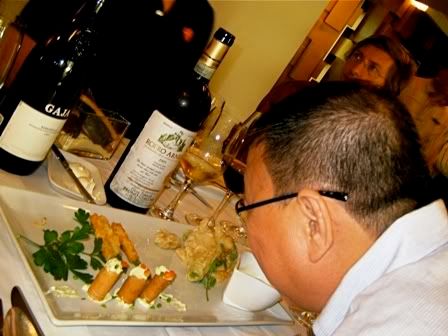 With all these, we had:
With all these, we had: 2005 Bruno Giacosa Roero Arneis - Until the Stockbroker pointed out what "arneis" was, Othmar and I were wondering what grape made up this wine. Othmar said it displayed some similar characteristics to sauvignon blanc - but was not sauvignon blanc - and also vaguely reminded him of Chablis (probably the tense minerality). I saw the similarities he stated and opined that it tasted like a barely-oaked version of the Tuscan vernaccia di San Gimignano.
2005 Bruno Giacosa Roero Arneis - Until the Stockbroker pointed out what "arneis" was, Othmar and I were wondering what grape made up this wine. Othmar said it displayed some similar characteristics to sauvignon blanc - but was not sauvignon blanc - and also vaguely reminded him of Chablis (probably the tense minerality). I saw the similarities he stated and opined that it tasted like a barely-oaked version of the Tuscan vernaccia di San Gimignano. "Arneis", as it turns out, is the grape from which the wine is made, and "Roero" the area in the Renesio district of Canale then ruled by, and, I suppose, named after, the Roero family, a.k.a., the Lords of Canale, as far back as the 1400s.
"Arneis", as it turns out, is the grape from which the wine is made, and "Roero" the area in the Renesio district of Canale then ruled by, and, I suppose, named after, the Roero family, a.k.a., the Lords of Canale, as far back as the 1400s.My handwritten notes state:
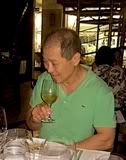
Initially mild grapefruit, grass, minerals, pear, white peppery apple, citrus (including lime in the nose but not on the palate) whisper of acetone (but not off-putting). In the mouth, apple and pear lead the way with a bit of citrus; grapefruit/grassiness surface more slightly past mid-mouth, joined by bitter-almondy nuances Italians favor in their aperitifs. Citrus, lemon and the almond notes tend to dominate the apple/pear in the long, slightly alcoholic finish (14%abv).
Appetizingly dry, fresh, medium-bodied, nicely consistent minerality. Its fresh citrus/lemon/grapefruit/grass/mineral notes married very well with the appetizers, especially the Diwal and Squash Flowers Tempura.
~ oOo ~
After the appetizers, a small serving of pasta, and, then, the Steak alla Fiorentina main course arrived (not nearly as rare as I like it, but still very nice) to pair with the macho Piedmontese reds.
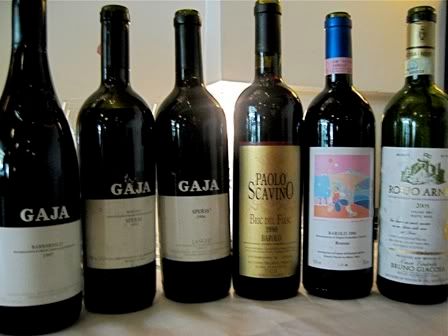
First Flight:
 1997 Gaja Barbaresco - This was, to my mind, the red easiest to drink and enjoy, and not surprisingly as Barbarescos (also made up of nebbiolo grapes from the same-named DOCG area neighboring Barolo) mature significantly faster than and are never really as "tough" as Barolos.
1997 Gaja Barbaresco - This was, to my mind, the red easiest to drink and enjoy, and not surprisingly as Barbarescos (also made up of nebbiolo grapes from the same-named DOCG area neighboring Barolo) mature significantly faster than and are never really as "tough" as Barolos.Juicy, well-extracted, ripe, black cherry, dark fruit, some raspberry, touch of raisins, with olive and mushroom nuances. Violet notes surface mid-mouth and continue to the confident, tartish sour-cherry finish. The bouquet gained an alluring touch of gaminess after material breathing in my glass. Nice depth and layering. Smooth, velvety tannins.
Nicely round full body (though not nearly as full as both the succeeding Gaja Sperss) and precise weight. I really enjoyed this - very nice alone and even better with the steak.
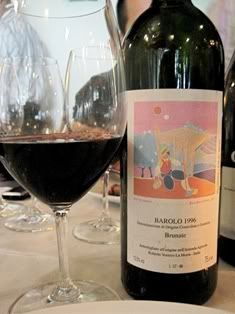 1996 Roberto Voerzio Barolo Brunate - Everyone but I seemed quite familiar with this maker, a relatively young producer making great waves with his single-vineyard Barolos, as I understand.
1996 Roberto Voerzio Barolo Brunate - Everyone but I seemed quite familiar with this maker, a relatively young producer making great waves with his single-vineyard Barolos, as I understand.Comparatively not as deeply veined in fruit (probably not yet displaying fully) as the preceding wine, but with brighter fruit (black cherry-dominant) and more surface red berry (there is material strawberry in the dominant black cherry). Dark fruit and black coffee undertones with slight notes of fig and violets. Tart cherry dominates the finish.
Obviously powerful, but not in a bearish way at all - more like a sleekly muscled gymnast than a weightlifter. Tremendous yet precise push on the palate - admirable focus and definition in this wine - not overly extracted or super-ripe like many modern-styled wines. Very clean lines. Comparatively, it may come off as a bit overly stern, angular and tight right now, with a long, strong, very tannic finish - but I believe this will ease and loosen up as the wine continues to mature. Notable balance, and, in my opinion, with potential for future elegance.
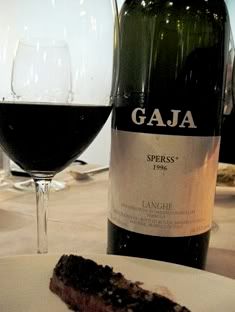 1996 Gaja Barolo Sperss - Bigger, darkly ripe, very full, but with good focus and notable balance. Lots of black coffee, touches of leather and tar in its mildly earthy (whisper of mushrooms) dark fruit/cassis/violets underlying the black cherry, raspberry notes. Very deeply-veined fruit. Not (yet?) displaying the layering of the Barbaresco, but more than adequate in complexity.
1996 Gaja Barolo Sperss - Bigger, darkly ripe, very full, but with good focus and notable balance. Lots of black coffee, touches of leather and tar in its mildly earthy (whisper of mushrooms) dark fruit/cassis/violets underlying the black cherry, raspberry notes. Very deeply-veined fruit. Not (yet?) displaying the layering of the Barbaresco, but more than adequate in complexity. Powerful as well, but not as laser-focused as the above-described Brunate. A bit tough and stern, it was much easier to appreciate with the steak, but, then, I've always believed that Barolos were really meant to be enjoyed with hearty cuts of roasted meat, especially game.
Powerful as well, but not as laser-focused as the above-described Brunate. A bit tough and stern, it was much easier to appreciate with the steak, but, then, I've always believed that Barolos were really meant to be enjoyed with hearty cuts of roasted meat, especially game.In my opinion, with more years in bottle (5-8 years), this will probably be the best wine among all the other Barolos.
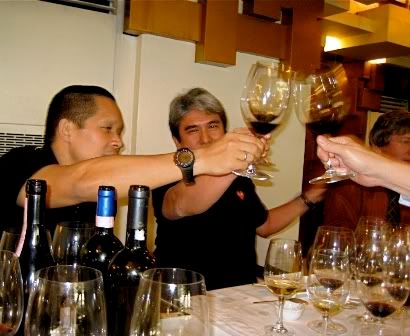
Second Flight:
 1990 Paolo Scavino Barolo Bric dël Fiasc - Much more subtle and warmly comforting than the '96s. Less tannic, rounder, smoother, touches of fig with a pervasive raisin character to its fruit. Seems to be more dark fruit than red here (more raspberry in this than the others).
1990 Paolo Scavino Barolo Bric dël Fiasc - Much more subtle and warmly comforting than the '96s. Less tannic, rounder, smoother, touches of fig with a pervasive raisin character to its fruit. Seems to be more dark fruit than red here (more raspberry in this than the others). Oscar immediately noted slight oxidation that, I found, expressed itself more and more as it breathed in glass - with telltale sherry-like notes - but , for a great part, not to the extent as to be unpleasant. Personally, it added a bit of sad, wistful nostalgia that the romantic in me enjoyed.
Oscar immediately noted slight oxidation that, I found, expressed itself more and more as it breathed in glass - with telltale sherry-like notes - but , for a great part, not to the extent as to be unpleasant. Personally, it added a bit of sad, wistful nostalgia that the romantic in me enjoyed.Tragically, the sherry notes kept pushing forward and I stopped drinking it as it began to over-power all the other notes.
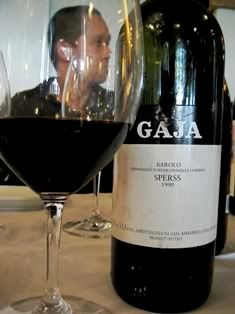 1990 Gaja Barolo Sperss - There were, initially, slight saline/marine scents to this which, thankfully, blew off after a while. I noted that the bouquet of this wine was comparatively quite reticent compared to those of the other reds.
1990 Gaja Barolo Sperss - There were, initially, slight saline/marine scents to this which, thankfully, blew off after a while. I noted that the bouquet of this wine was comparatively quite reticent compared to those of the other reds.In the mouth, however, it was wonderful. Suavely masculine, in great shape despite its 18+ years, actually, it seemed quite youthful, belying its age. Clean, classic lines, well-focused, great balance of power and grace. Elegant touches of truffle and violets. I think this can age for many more years, but I doubt it will flesh out more than now.
I remember wishing there was still some steak left to enjoy this with. I had it with a bit of the Roquefort and guava compote, though, and it was superb - the cheese's gaminess ran with the wine's truffle notes, the compote's sweetness cut tempered both the wine's and cheese's power, and the wine's acidity cut the cheese's richness. Absolutely lovely.
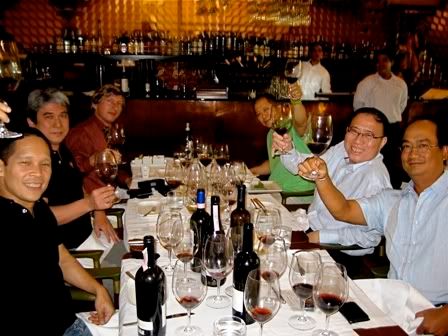 An excellent lunch by all accounts: great wines, food, pairing and friends. Grazie infinite, amico mio!
An excellent lunch by all accounts: great wines, food, pairing and friends. Grazie infinite, amico mio!
Friday, January 16, 2009
French Dinner à la Taillevent.
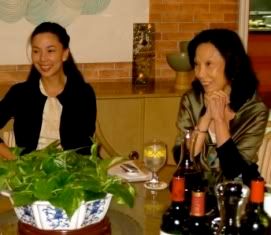
Last night's dinner (15th January 2009) by young chef, Ian Padilla, was organized and held by Tita B at her elegant residence. Ian currently cooks at 2-Michelin star Taillevent in Paris (3-Michelin star for decades until February of 2007), but is in town for the next couple of weeks, available for private dinners.
Rene contacted us about his dinner a week or so ago and I unhesitatingly confirmed my wife and my attendance. We were to be 11 in all at at table. The days leading up to the dinner, Rene, Miguel and I discussed and, eventually, completed the wine list to pair with the multiple courses.
 Christine Oro (chef of the Hyatt's Fireplace) and Ian Padilla of Taillevent in Tita B's kitchen
Christine Oro (chef of the Hyatt's Fireplace) and Ian Padilla of Taillevent in Tita B's kitchen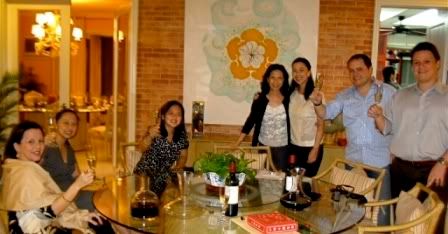 As in any civilized dinner, we started of with glasses of well-chilled bubbly while the reds started breathing in their decanters.
As in any civilized dinner, we started of with glasses of well-chilled bubbly while the reds started breathing in their decanters.
 Cattier Champagne Clos du Moulin - From
Cattier Champagne Clos du Moulin - FromRene. This single vineyard bubbly also happens to be one of the Doc's "go-to" non-vintage champagnes. Cattier's 2.2 hectare Clos du Moulin is one of only three walled vineyards in the entire Champagne region, and the self-named cuvée is always a blend of three select vintages. This particular clos is regarded as a "premier cru vineyard".
 Originally named "Clos Allart" after its old owner, Allart de Maisonneuve, an officer of Louis XV, the clos was renamed after its purchase by Jean Cattier in 1951. The vineyard is planted to roughly equal proportions of pinot noir and chardonnay.
Originally named "Clos Allart" after its old owner, Allart de Maisonneuve, an officer of Louis XV, the clos was renamed after its purchase by Jean Cattier in 1951. The vineyard is planted to roughly equal proportions of pinot noir and chardonnay.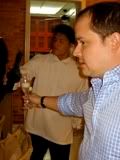 Very fresh, bright and lively, this linear, youthful-tasting champagne is citrus and crisp green apple driven with pronounced mineral, bread and yeast notes and a very slight "biscuity" nuance barely past mid-mouth. I didn't remember to check the back label to see which three vintages were blended in this, but, I'd hazard this is likely the most current release, or, if not, the one just before it at the most.
Very fresh, bright and lively, this linear, youthful-tasting champagne is citrus and crisp green apple driven with pronounced mineral, bread and yeast notes and a very slight "biscuity" nuance barely past mid-mouth. I didn't remember to check the back label to see which three vintages were blended in this, but, I'd hazard this is likely the most current release, or, if not, the one just before it at the most.Bracing acidity brings a playful zing to it. Some grapefruit emerges towards the back, and citrus notes dominate the finish. Good definition and focus in the fruit, if slightly overstated in citrus. Will likely round out and "creamify" later in life.
~ oOo ~

After Tita B put the last finishing touches on her table, Sunshine then seated us at our proper places for the parade of courses, which started off with an assortment of amuse bouches: Tarragon Infused Tomato Water & Extra Virgin Olive Oil; Carrot Parfait, Fried Ginger and Carrot Paint; Deviled Quail Egg with Basil Yolk; and, Braised Beef Wanton with Thyme and Fluer de Sel. With the battery of amuse bouches, we had:
 2005 Domaine Henri Bourgeois La Demoiselle de Bourgeois Pouilly-Fumé - My bottle. I remember the first time I had this was at the IWFS Philippine Branch's 25 Anniversary Dinner precisely paired with Fillet of Sea Bass on Celery Leek Ragout; seared Coffin Bay Scallop and Sea Urchin Beurre Blanc. Come to think of it, I recall having discussed this wine with Rene, Sr. during that dinner. I loved it then, had it several times thereafter, and still love it now.
2005 Domaine Henri Bourgeois La Demoiselle de Bourgeois Pouilly-Fumé - My bottle. I remember the first time I had this was at the IWFS Philippine Branch's 25 Anniversary Dinner precisely paired with Fillet of Sea Bass on Celery Leek Ragout; seared Coffin Bay Scallop and Sea Urchin Beurre Blanc. Come to think of it, I recall having discussed this wine with Rene, Sr. during that dinner. I loved it then, had it several times thereafter, and still love it now.I believe I've mentioned before that Domaine Henri Bourgeois is one of the very highly-regarded makers of Sancerre and Pouilly-Fumé, both sauvignon blanc dominated appellations located in the Loire.
My previous notes are still pretty accurate, the wine lip-smackingly dry, crisp and bright with clean citrus, mild gooseberry and guava notes, a whisper of celery, inherent white minerality and healthy acidity giving a nice lift . I add now that the wine's fruit, particularly the guava, seems riper and is notably more forward then over a year ago.
I chose this wine primarily because Pouilly-Fumé (and Sancerre blancs as well) is one of the few wines that can pair naturally well with the usually wine-unfriendly tomato; and, secondly, because I knew it would pair well with the fish course and the immediately following soup of Roasted Shallot Bisque, Crème Fraiche with Stewed Onions and Chive Oil as well.
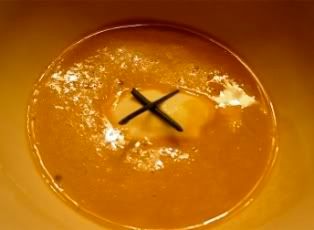
 I must, at this point, note that each and every course was ably and properly announced and described by Ian in a most affable and approachable manner.
I must, at this point, note that each and every course was ably and properly announced and described by Ian in a most affable and approachable manner.The tarragon infused tomato water with extra virgin olive oil was a delightfully cleansing palate-primer which called to mind a somewhat similar, cool tomato essence soup with lobster that I and several old friends enjoyed almost 4 years ago in the Peninsula Hong Kong's Gaddi where we collectively celebrated our 40th birthdays.
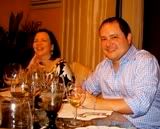 Flashback over, the carrot parfait was ethereally textured and gently sweet, favored by Tita B and most everyone else at the table. I, personally, loved the deviled quail egg with basil yolk, myself since I've loved deviled eggs ever since childhood - the green, basil infused yolk a delight to the eyes and the mouth, while the braised beef wanton with thyme and fleur de sel readied our palates for the heavier fare to come.
Flashback over, the carrot parfait was ethereally textured and gently sweet, favored by Tita B and most everyone else at the table. I, personally, loved the deviled quail egg with basil yolk, myself since I've loved deviled eggs ever since childhood - the green, basil infused yolk a delight to the eyes and the mouth, while the braised beef wanton with thyme and fleur de sel readied our palates for the heavier fare to come.The roasted shallot bisque was precisely executed- not ponderously creamy as most bisques are in these parts, rather, it was properly fluid as a bisque should be without giving up any body or flavor despite the judicious use of cream.
~ oOo ~
Following the soup course was a Roulade of Squab Confit with a Salad of Haricot Vert, Radish, Watercress, Caper and Date Puree with which we switched to:
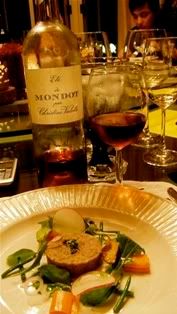 Eté de Mondot par Christine Valette - My bottle. The rosé of Château Troplong Mondot of St-Emilion which Chrisitine Valette owns and runs. Rene noted that the label carried no vintage. Curious, I looked it up, and, per Jancis Robinson, the reason is because Bordeaux authorities refused to grant the Bordeaux "clairet" (i.e., what Bordeaux rosés are traditionally called) appellation to this wine because they thought it too darkly colored.
Eté de Mondot par Christine Valette - My bottle. The rosé of Château Troplong Mondot of St-Emilion which Chrisitine Valette owns and runs. Rene noted that the label carried no vintage. Curious, I looked it up, and, per Jancis Robinson, the reason is because Bordeaux authorities refused to grant the Bordeaux "clairet" (i.e., what Bordeaux rosés are traditionally called) appellation to this wine because they thought it too darkly colored.I hadn't tried this particular rosé before but figured it should go well enough with the dark-meated squab confit roulade because of the predominance of merlot in the vineyards of Troplong Mondot typical of St-Emilion. The Vigneron took a group of friends, myself included, to Château Troplong Mondot for a visit and wine-tasting in July 2006 - a visit that was, shall we say, the least eventful of all the châteaux we visited that trip.
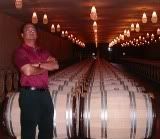 In any event, this dark ripe plum and black cherry and raspberry dominant, lightly cedared and spiced rosé, fuller and more rounded than most any rosé I've ever had (except the 2005 Rosée de Pavie), matched very well with the squab confit roulade. I had earlier thought of pairing it with a 2001 Badia a Passignano until Rene reminded me that the fish dish would follow. That meant we'd have to switch back to the 2005 La Demoiselle de Bourgeois - which, to me, would be too awkward. Happily, the Eté de Troplong married very well.
In any event, this dark ripe plum and black cherry and raspberry dominant, lightly cedared and spiced rosé, fuller and more rounded than most any rosé I've ever had (except the 2005 Rosée de Pavie), matched very well with the squab confit roulade. I had earlier thought of pairing it with a 2001 Badia a Passignano until Rene reminded me that the fish dish would follow. That meant we'd have to switch back to the 2005 La Demoiselle de Bourgeois - which, to me, would be too awkward. Happily, the Eté de Troplong married very well.~ oOo ~
The next course was an indulgent Macadamia Nut-Crusted Foie Gras with Caramelized Banana and Chocolate Sauce...
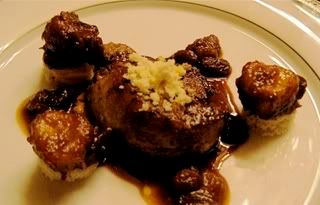 ...which Rene paired with his bottle of:
...which Rene paired with his bottle of: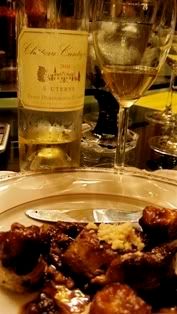 2004 Château Cantegril - Technically, this is a Barsac rather than a Sauternes. As such, it is typically leaner, lither, brighter in acid and faster to mature than the generally heavier, richer Sauternes. This particular château is owned and run by Denis and Jeanine Dubourdieu. Denis Dobourdieu is one of the most famous and successful wine consultants in France and the world; much of the relatively recent successes of Château La Lagune, among others, are credited to his efforts. Aside from all this, he and his family also own and run 2nd growth Château Doisy-Daëne in Barsac.
2004 Château Cantegril - Technically, this is a Barsac rather than a Sauternes. As such, it is typically leaner, lither, brighter in acid and faster to mature than the generally heavier, richer Sauternes. This particular château is owned and run by Denis and Jeanine Dubourdieu. Denis Dobourdieu is one of the most famous and successful wine consultants in France and the world; much of the relatively recent successes of Château La Lagune, among others, are credited to his efforts. Aside from all this, he and his family also own and run 2nd growth Château Doisy-Daëne in Barsac.Sauternes/Barsac wines are traditionally paired in the area with foie gras. It is one of those pairings that has stood the test of time and is ubiquitous in most any legitimate fine dining restaurant in the world. Because of the chocolate sauce, however, I wanted to pair this with a Banyuls or Rasteau Vin du Naturel, but, alas, I had none in stock and couldn't find any locally. No matter, though, the traditional pairing came through wonderfully.
The wines languidly viscous texture was infused with flavors of lemon cream, sweet, ripe cling peach, just a touch of dried apricot, slight vanilla/oak and undertones of candied lemon peel and orange rind. A good dose of balancing acidity helped brighten the sweetness, emphasized the lemon notes, cut and played with the foie's inherent richness.
~ oOo ~
This was followed by Poached Egg with Duck Fat, Truffle Oil, Roasted Mushrooms, Mushroom Consommé and Chives. An absolute delight for me who adores all manifestations and variations of Oeuf Cocotte.
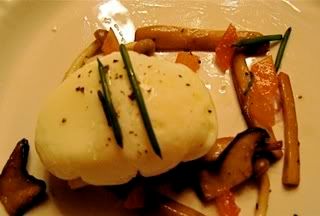 With this, I counseled no wine at all. I've tried many to pair with these types of egg dishes but I've never been convinced with the pairings - even with the traditional oeufs en meurette. Alone, the earthy roasted mushrooms and truffle oil elevated the humble poached egg while the hint of duck fat gave added dimensions of savoriness and luxury.
With this, I counseled no wine at all. I've tried many to pair with these types of egg dishes but I've never been convinced with the pairings - even with the traditional oeufs en meurette. Alone, the earthy roasted mushrooms and truffle oil elevated the humble poached egg while the hint of duck fat gave added dimensions of savoriness and luxury. Next was a refreshing Green Tea and Melon Sorbet. I was happy to see this somewhat neutrally flavored sorbet. Many restaurants tend to serve aggressively flavored sorbets before the main courses which, in my experience, seriously affects the palate, and therefor, my ability to properly taste the succeeding wines, for a disturbingly long period of time. Some of these take the form of tart raspberry, calamansi or even the dreaded aggressive basil. In such cases, I skip the sorbet altogether. Last night, however, the chef's choices were judicious and his hand light. Good show.
Next was a refreshing Green Tea and Melon Sorbet. I was happy to see this somewhat neutrally flavored sorbet. Many restaurants tend to serve aggressively flavored sorbets before the main courses which, in my experience, seriously affects the palate, and therefor, my ability to properly taste the succeeding wines, for a disturbingly long period of time. Some of these take the form of tart raspberry, calamansi or even the dreaded aggressive basil. In such cases, I skip the sorbet altogether. Last night, however, the chef's choices were judicious and his hand light. Good show.~ oOo ~
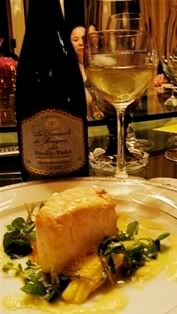 Then came the fish course of Roasted Escolar “Sandre,” Citrus Marmalade, Salad of Sweet Corn and Mushrooms. With this perfectly cooked, juicily "meaty" cod, delicately hit with subtle touches of citrus and the corn's natural sweetness, we continued with a second bottle of 2005 La Demoiselle de Bourgeois Pouilly-Fumé.
Then came the fish course of Roasted Escolar “Sandre,” Citrus Marmalade, Salad of Sweet Corn and Mushrooms. With this perfectly cooked, juicily "meaty" cod, delicately hit with subtle touches of citrus and the corn's natural sweetness, we continued with a second bottle of 2005 La Demoiselle de Bourgeois Pouilly-Fumé.When I was first e-mailed the menu, I thought the fish was going to be sandre, i.e., pickerel, a.k.a., pike-perch, that I ate a few times in Bordeaux and the Loire. I was actually very curious how the chef had gotten hold of some because, as far as I knew, the sandre is found only in Europe. It turned out that the chef was referring to "sandre" as a manner of cooking with indirect heat. I'd never heard of that term before for that manner of cooking, but, then, I'm no French chef.
The wine married well as I expected, the forward, ripe guava notes taking the lead, with enough push and body to stand up well to this inherently oily (but in a good way), "meaty" fish.
~ oOo ~
Then came the meat, in the form of Certified Angus Beef Braised Short Ribs with Purée Du Pomme de Terre, Bearnaise Beignets and Thyme Natural Jus. Marinated for 24 hours before being gently braised for 8 more, the short rib chunk could literally be taken apart with a spoon - not mushy at all, mind you, its integrity was somehow maintained, albeit extremely tender.
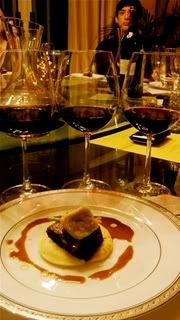 With this we had 3 reds from Bordeaux, two from Pauillac, one from Pessac-Léognan, all decanted and breathing for over 2½ hours by the time the meat course was served.
With this we had 3 reds from Bordeaux, two from Pauillac, one from Pessac-Léognan, all decanted and breathing for over 2½ hours by the time the meat course was served.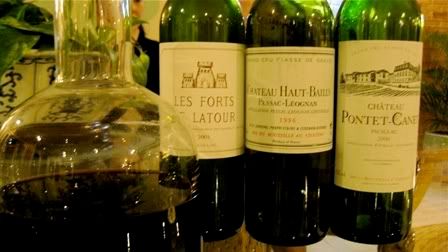 2001 Les Forts de Latour (Pauillac) - My bottle. Though known as the 2nd wine of the venerable 1855 Classified 1st Growth, Château Latour, Les Forts is, as the Stockbroker told me, technically a separate wine in itself as the grapes generally come from vineyards (of under 12 year old vines) separate from those of the grand vin. At times, however, per the chateau's website, the juice from certain vats of the grand vin vineyards find their way into Les Forts.
2001 Les Forts de Latour (Pauillac) - My bottle. Though known as the 2nd wine of the venerable 1855 Classified 1st Growth, Château Latour, Les Forts is, as the Stockbroker told me, technically a separate wine in itself as the grapes generally come from vineyards (of under 12 year old vines) separate from those of the grand vin. At times, however, per the chateau's website, the juice from certain vats of the grand vin vineyards find their way into Les Forts.I last opened one of my bottles of these for lunch at Old Manila around 6 months ago, on 11th July 2008 to be exact. My notes then are still applicable:
Forgive me, but I can't help but keep crowing about how I bought aThis wine is still quite young and has yet to fully come together. I'd think 3-5 more years ageing should do nicely.
case-and-a-half of this around 3½ years ago at a mere $37 per bottle. Now,
unless you buy it by the case at almost double the price from Corporate Wines,
the price for this begins at $130 per bottle and upwards.
...(A) legitimately full-bodied wine, expansive, broad, generous on the
palate and confident in its hefty molten black fruit, cassis, leather, tobacco,
cedar, touch of asphalt, hint of cigar box. Mouth-filling, smooth, very
masculine, if not exceedingly complex or intellectual. At my acquisition cost, a
steal.
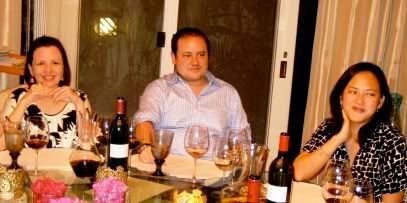 2000 Château Pontet-Canet (Pauillac) - Rene's bottle. We tried this around 7 months ago at Santi's place. My notes then were as follows:
2000 Château Pontet-Canet (Pauillac) - Rene's bottle. We tried this around 7 months ago at Santi's place. My notes then were as follows:This was the young bruiser of the bunch, eagerly unleashing rolling muscle under a lush, ripe, almost velvety glove. Black fruit, cassis over licorice dominated with hints of red cherry, gravel and minerals in a long and strong finish. Good, sturdy bones in this. Impressive for a barely 8 year-old Pauillac, I 'd surelyNow, I add that though the wine had noticeably softened in the last 7 months and with material breathing time, it was still obviously the most muscular and "modern styled" Bordeaux of the bunch. In addition, the round-ripeness of the vintage was a lot more apparent in the dark fruit, there was a touch of sweet-ripeness to it.
like to try this again in 3 years' time and follow its evolution over the next
20 years.
I suspect this will age nicely (it certainly appears to have the structure for it), the red cherries surfacing more in time and the wine turning subtle and sweeter in 10years from now.
Though I expected this to be too young to really be enjoyable at this point, I suppose my experience with the 2001 vintage around 2-3 years ago caused me to think this of the 2000 before I tried it. I am happy to admit that I was wrong. Were it that all my mistakes were this pleasurable.
Rob shared a joke about liking a wine because it was "matamis". I guess one had to have been there (and imbibed just as much) for it to be as funny as it really was at the time.

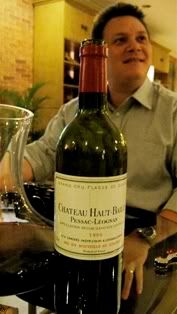 1996 Château Haut-Bailly (Pessac-Léognan) - Miguel's bottle. The most recent notes I have on this wine are from mid-December 2007, a little over a year ago. It may not necessarily be the last time I had it, I do not always take down or post notes, much less every time I re-taste a particular wine in short intervals. In any event, those year-old notes are as follows:
1996 Château Haut-Bailly (Pessac-Léognan) - Miguel's bottle. The most recent notes I have on this wine are from mid-December 2007, a little over a year ago. It may not necessarily be the last time I had it, I do not always take down or post notes, much less every time I re-taste a particular wine in short intervals. In any event, those year-old notes are as follows:It displayed decent, gravelly/graphite laced earthy black fruit with a slight touch of red fruit surfacing slightly past mid-palate. More than decentMy opinion and fondness for Haut-Bailly's wines have not changed, and, for this particular vintage, has even deepened. With over a year more in bottle, and with material breathing time at that, the wine has gained a lot more depth - even contemplativeness.
Pessac-Leognan, but, then, I am admittedly biased towards this château, considering it a consistently typical, reliable Graves that is priced below its
performance.
It is much more open (though properly reserved) and complex at this point, displaying added tobacco, roasted herbs and warm asphalt and gravel to its darkly spiced dark fruit and cassis. Surface red berries twinkle near the surface. Excellent wine, my red of the night - yet another ringing testament to the excellence of the 1996 vintage.
~ oOo ~
Next was our "pre-dessert" course (most likely a spin off the usual cheese with fruit/fruit compote course served before dessert) of Sweet Baby Pineapple Baked in Salt and Pink Peppercorn Crust served with Ricotta and Basil.
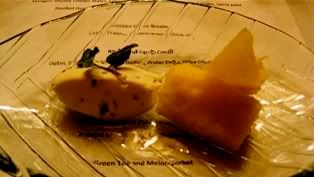 As Ian described, the baby pineapple was as juicily sweet as it was tender, but still with a good cleansing hit of tartness that the salt and pink peppercorn dust played off of. The ricotta's somewhat restrained creaminess foreshadowed dessert's indulgence, while the basil lent a breath of freshness to the cheese.
As Ian described, the baby pineapple was as juicily sweet as it was tender, but still with a good cleansing hit of tartness that the salt and pink peppercorn dust played off of. The ricotta's somewhat restrained creaminess foreshadowed dessert's indulgence, while the basil lent a breath of freshness to the cheese.I must have been more than a little tipsy by that time because I didn't even notice that we opened no pairing wines for this course and our dessert - if we did, I've forgotten all about it. Very unusual for me. In any event, our moderately decadent Terrine of Chocolate, Glazed Fruits, Custard Sauce and Pistachios really didn't need any wine to go with it.
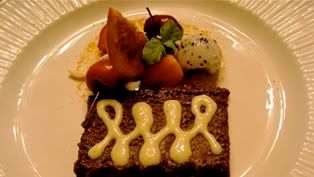 Service finally done, our young chefs came out and joined us at the table...
Service finally done, our young chefs came out and joined us at the table...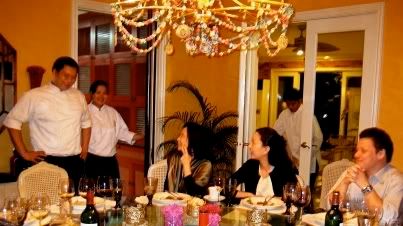 ...sharing some glasses of wine, stories of their culinary adventures and some jokes as well.
...sharing some glasses of wine, stories of their culinary adventures and some jokes as well.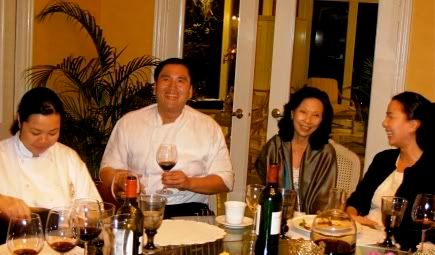
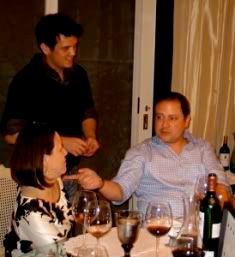 The rest of the evening seems a blur now. I know we wound up finishing all the bottles despite Tita B, Sunshine and Anna not drinking at all and, as I saw it, Aimee and Ria didn't really drink much. That left me, Miguel, Rene, Rob, Joe and my wife as the usual suspects...well, with a belated bit of aiding and abetting from the chefs.
The rest of the evening seems a blur now. I know we wound up finishing all the bottles despite Tita B, Sunshine and Anna not drinking at all and, as I saw it, Aimee and Ria didn't really drink much. That left me, Miguel, Rene, Rob, Joe and my wife as the usual suspects...well, with a belated bit of aiding and abetting from the chefs.I do recall having an espresso (whether it was a single or double is lost in time and alcohol). We were made to choose our respective coffees. I think Miguel just chose for me and Rob acted as a most capable barista for the night, pulling caffeine shots for everyone. He was using this Nespresso machine that I think Miguel brought back from Spain.
Most enjoyable evening. Thanks to Tita B for organizing this and having us again at her home. It certainly was nice to have her at the table with us this time. To the chefs, a job very well done. To contact Ian for private dinners, one may call 0917 803 5423.
Subscribe to:
Posts (Atom)
